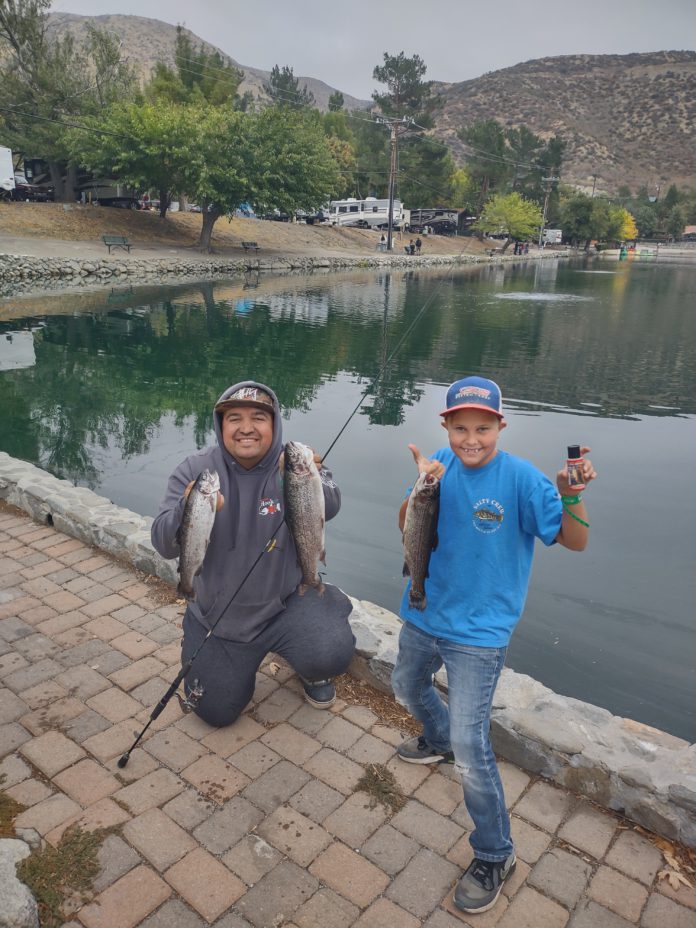
Jess Ranch Hatchery plants first trout in over two years at Mountain Lakes
BY ANDREW MACK
LYTLE CREEK – With the colder weather moving in and now being almost in November, it’s definitely the start of trout season. Mountain Lakes kicked off its first stocking of trout this past Thursday with 1,000 pounds of rainbow trout from Jess Ranch in Apple Valley. As a refresher, Jess Ranch was one of the hatcheries that has been closed for two years since the fish kill off due to the virus. They had to drain all the water and get rid of the fish to start fresh. So it’s taken two years to get back to stocking again, but this first batch of fish came in strong and decent size.
With the average trout from this stocking going 2 to 3 pounds, they were healthy and great fighters. After a couple tough years, it was great to see one of the area’s hatcheries back in action. This reporter fished Mountain Lakes on Friday for the opener and was able to stick a limit of trout in a few hours using a yellow/white Hookup Bait dipped in Bite-On red crimson. These fish were way more aggressive than prior years of fish coming from here. Often in the past, the Jess Ranch trout would take a few days to become active. Now I’m not sure if it’s this new strain of fish, but they were very fun to catch.
I returned on Sunday morning and was able to hook another limit of fish. This time I brought up my friend Jason Sage with his son Kyle Sage, who just turned 10 years old and wanted to go fishing for his birthday. Kyle stuck one trout as well on a hook up bait then switched tactics to catch bass and bluegill. He was able to catch a mixed bag of around 50 fish with mostly bluegill in the mix.
Mountain Lakes is a private camping resort that usually is the first SoCal lake to start trout season earlier than most. They will continue to stock 1,000 pounds of trout every week that they will split between both lakes until April.
Disease strikes Hot Creek Trout Hatchery for the second time
Vaccinations underway for uninfected fish
MAMMOTH LAKES – The California Department of Fish and Wildlife (CDFW) has detected a bacterial outbreak at its Hot Creek Trout Hatchery in Mono County – the second time in 2021 that Lactococcus garvieae has been confirmed in some trout at the hatchery.
Three distinct groups of trout representing about 15 percent of the hatchery’s total trout population have tested positive. CDFW has quarantined the facility, temporarily suspended fish planting and is preparing to humanely euthanize infected fish and vaccinate uninfected stocks.
“The encouraging news is that we caught the outbreak early as part of our routine testing and only a portion of the hatchery’s trout has been infected,” said Jay Rowan, CDFW’s statewide hatchery program manager. “We now have proven and effective vaccines to protect uninfected fish – vaccines developed recently in a partnership between UC Davis and CDFW. We’re in the process of vaccinating the hatchery’s healthy fish populations. Unfortunately, we don’t have a cure or treatment for infected fish at this time.”
Hot Creek Trout Hatchery is located south of Mammoth Lakes and raises three species of trout – rainbow, brown and Lahontan cutthroat – for stocking into some blue-ribbon eastern Sierra fisheries, including Crowley Lake, Pleasant Valley Reservoir and portions of the Owens River. CDFW expects low to moderate impacts to waters stocked by the Hot Creek Trout Hatchery in 2022.
The 15 percent of infected fish consist of 118,000 rainbow trout and 52,000 brown trout, including 2,000 broodstock brown trout weighing 2 to 3 pounds each.
Nearly a million fish have tested negative and will undergo vaccination, either through a bath immersion process for smaller, juvenile fish or injection into larger fish. These healthy populations include rainbow trout broodstock, brown trout broodstock, rainbow and brown trout of various sizes, and juvenile Lahontan cutthroat trout. Once vaccinated, the fish will be safe to plant and safe for anglers to consume.
Lactococcus garvieae is the same disease that forced the quarantine and suspension of fish planting last year at three other CDFW trout hatcheries in Southern California and the eastern Sierra – the Mojave River Hatchery, Black Rock Trout Hatchery and Fish Springs Trout Hatchery. That outbreak ultimately forced the euthanization of 3.2 million trout at those hatcheries.
All three hatcheries have undergone intensive cleaning, disinfection and are raising fish once again. Fish Springs and Black Rock are back stocking trout for recreational fishing. Those two hatcheries have vaccinated all of their fish stocks, which continue to test negative for the disease.
Isolation of Lactococcus garvieae in a few fish at the Hot Creek Trout Hatchery earlier this year resulted in the temporary quarantine of the facility and the suspension of fish stocking. Other CDFW trout hatcheries outside of the eastern Sierra have assisted stocking waters in Inyo and Mono counties while the Hot Creek Trout Hatchery has been offline and while Fish Springs and Black Rock were rebuilding their fish populations.
The outbreak of Lactococcus garvieae, which is similar to streptococcus or strep throat, has been reported in cattle and poultry farms as well as fresh and saltwater fish and shellfish hatcheries around the world. It had never before been detected in fish in California until the hatchery outbreaks in 2020.
Fish that are infected with Lactococcus garvieae can show symptoms that include bulging eyes, lethargic or erratic swimming and increased mortality, or be asymptomatic and show no signs of infection depending on several factors, including water temperature and stress.
Fish-to-human transmission of the bacteria is rare and unlikely but there are several documented instances associated with immunocompromised people consuming infected raw fish and unpasteurized milk products.



